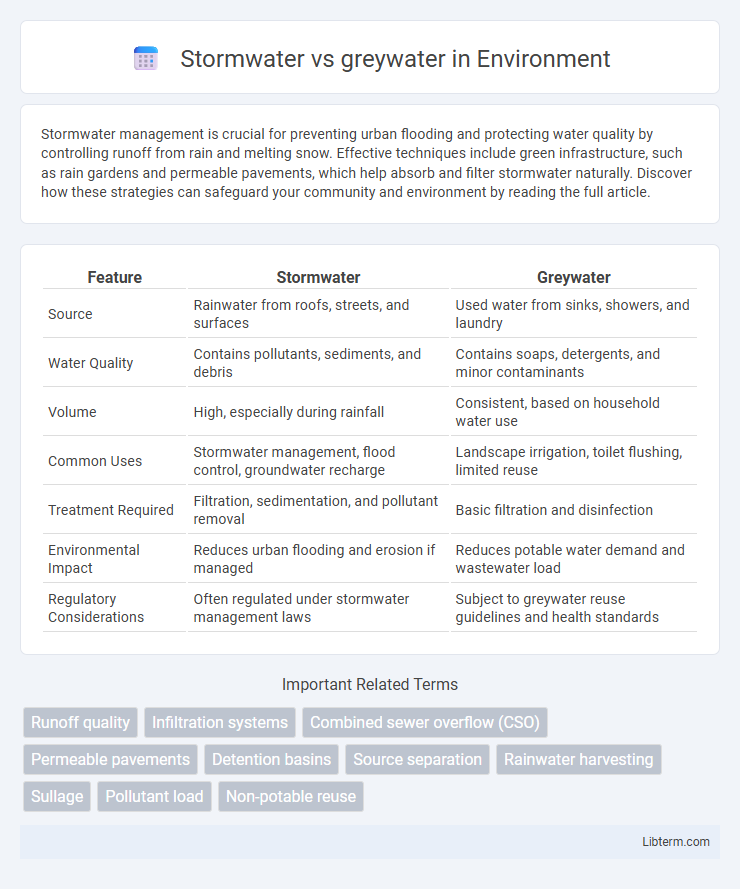Stormwater management is crucial for preventing urban flooding and protecting water quality by controlling runoff from rain and melting snow. Effective techniques include green infrastructure, such as rain gardens and permeable pavements, which help absorb and filter stormwater naturally. Discover how these strategies can safeguard your community and environment by reading the full article.
Table of Comparison
| Feature | Stormwater | Greywater |
|---|---|---|
| Source | Rainwater from roofs, streets, and surfaces | Used water from sinks, showers, and laundry |
| Water Quality | Contains pollutants, sediments, and debris | Contains soaps, detergents, and minor contaminants |
| Volume | High, especially during rainfall | Consistent, based on household water use |
| Common Uses | Stormwater management, flood control, groundwater recharge | Landscape irrigation, toilet flushing, limited reuse |
| Treatment Required | Filtration, sedimentation, and pollutant removal | Basic filtration and disinfection |
| Environmental Impact | Reduces urban flooding and erosion if managed | Reduces potable water demand and wastewater load |
| Regulatory Considerations | Often regulated under stormwater management laws | Subject to greywater reuse guidelines and health standards |
Introduction to Stormwater and Greywater
Stormwater refers to rainwater that flows over surfaces such as roads, rooftops, and landscapes, often carrying pollutants into water bodies. Greywater is wastewater generated from household activities like bathing, laundry, and dishwashing, excluding sewage from toilets. Understanding the distinct sources and compositions of stormwater and greywater is essential for effective water management and reuse strategies.
Defining Stormwater
Stormwater refers to rainwater or melted snow that flows over surfaces such as rooftops, streets, and lawns, often collecting pollutants before entering water bodies or drainage systems. Unlike greywater--which originates from household activities like bathing and washing--stormwater is primarily a natural runoff with significant impact on urban water management and flood control. Effective stormwater management is crucial for reducing pollution, mitigating flooding risks, and protecting aquatic ecosystems.
Understanding Greywater
Greywater refers to gently used water from bathroom sinks, showers, tubs, and washing machines, excluding toilet wastewater, and is relatively low in contaminants compared to blackwater. It can be treated and reused for irrigation, toilet flushing, and landscape maintenance, reducing freshwater demand and alleviating pressure on sewage treatment systems. Understanding greywater's quality and appropriate treatment methods is crucial for safe reuse, adhering to local regulations and health guidelines.
Key Differences Between Stormwater and Greywater
Stormwater consists of rainwater runoff from roofs, streets, and other impervious surfaces, while greywater originates from household sources such as showers, sinks, and laundry. Unlike stormwater, which is generally uncontaminated but can carry pollutants like oil and debris, greywater contains organic matter, soap, and detergents, requiring tailored treatment for reuse. Management practices differ significantly; stormwater systems focus on flood control and pollution prevention, whereas greywater systems prioritize water recycling for irrigation and non-potable uses.
Common Sources of Stormwater
Common sources of stormwater include rainfall runoff from impervious surfaces such as roads, parking lots, rooftops, and urban landscapes. Stormwater collects contaminants like oil, pesticides, sediment, and debris as it flows into drainage systems, impacting local waterways and ecosystems. Effective stormwater management involves capturing and treating runoff to reduce pollution and prevent flooding in urban areas.
Typical Sources of Greywater
Typical sources of greywater include household wastewater from sinks, showers, bathtubs, and washing machines, excluding toilets and kitchen sinks to avoid contamination with blackwater. This water is generally less polluted than stormwater runoff, which collects from surfaces like roofs, roads, and parking lots, often containing oils, debris, and chemicals. Collecting greywater involves localized household systems designed to capture water for irrigation or flushing toilets, enhancing water conservation efforts.
Stormwater Management Techniques
Stormwater management techniques include green infrastructure such as permeable pavements, rain gardens, and bioswales designed to reduce runoff and improve water quality by promoting infiltration and natural filtration. Detention basins and retention ponds temporarily store stormwater, controlling peak flows and preventing flooding in urban areas. Advanced systems integrate real-time monitoring and smart controls to optimize stormwater capture and reuse, reducing pressure on municipal sewer systems.
Greywater Recycling Methods
Greywater recycling methods commonly include filtration, biological treatment, and disinfection to remove contaminants and enable safe reuse for irrigation, toilet flushing, and landscape watering. Advanced systems often incorporate membrane bioreactors or constructed wetlands to enhance treatment efficiency and minimize pathogen risks. These eco-friendly techniques reduce potable water demand and decrease strain on municipal wastewater treatment facilities, promoting sustainable water management.
Environmental Impacts of Stormwater and Greywater
Stormwater carries pollutants such as oils, heavy metals, and sediments from urban surfaces into natural waterways, causing water quality degradation and habitat disruption. Greywater, primarily from household sources like sinks and showers, contains fewer contaminants but requires treatment to prevent microbial contamination and nutrient overload in soil and water systems. Proper management of both types reduces environmental harm by minimizing groundwater pollution, conserving freshwater resources, and supporting sustainable urban water cycles.
Best Practices for Sustainable Water Use
Stormwater management involves capturing and treating rainwater runoff to reduce flooding, recharge groundwater, and improve water quality, while greywater reuse focuses on recycling water from sinks, showers, and laundry for non-potable applications such as irrigation and toilet flushing. Best practices for sustainable water use include implementing rain gardens, permeable pavements, and detention basins for stormwater, alongside installing greywater recycling systems with proper filtration and regular maintenance to prevent contamination. Integrating both stormwater and greywater strategies maximizes water conservation, reduces demand on municipal supplies, and supports resilient urban water management.
Stormwater Infographic

 libterm.com
libterm.com